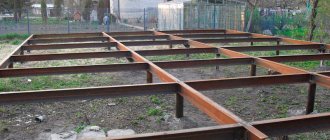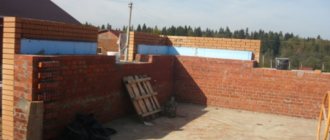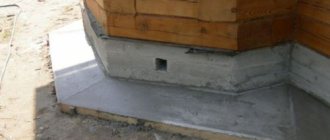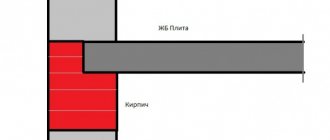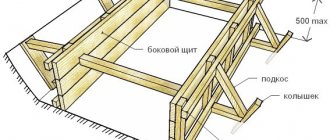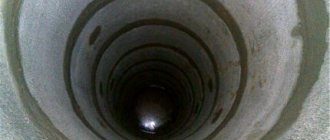Before starting the construction of any building, you need to know how to calculate bored piles correctly and with the highest accuracy. This must be done, if only because savings in construction are especially relevant today, and maximum savings are possible only by making an accurate calculation.
Scheme of the construction process of bored piles.
The calculation process itself will take place in the following stages, the sequence of which must be strictly observed:
- characteristics of soil and its properties;
- load of the construction site;
- foundation - area calculation;
- type, properties and quantities of pile and area;
- calculating the distance between piles.
Characteristics of soil and its properties
Table of soil characteristics.
To more accurately characterize the soil and its properties, it is necessary to dig 2-3 holes 2 meters deep. All this is necessary because the soil on the territory is always different. Next, the site will become the foundation of the house - the foundation. In this way, the site for construction will be the most suitable and preferable, which will significantly reduce the problems that may arise when the foundation begins to form.
Construction site load:
We perform accurate calculations of the load on bored piles. Now you should collect all the building materials in one place - a pile. This calculation is quite simple to perform, since here it is necessary to use standard volumetric mass values in a free table.
Foundation and its area: calculations
Today it is known that the number of bored piles used depends on the areas of the support and foundation. Consequently, it is necessary to make not just an accurate calculation, but also an economical one, since when using a certain area, the foundation thereby contributes to a significant reduction in the number of bored piles.
Example of calculations for bored piles:
The installation will use bored piles with a diameter of 30 cm and an expansion of at least 50 cm. Hence: the base of each support should be equal to: S = 4. 13 * 40 * 40 / 8 = 1950 cm2. In this way, a correct and accurate calculation is made.
If the load on any part of the foundation is 100 tons and the radius is 4, then you simply need to put in the above formula: R=F/(S*n). In this formula, n is the number of supports, the result will be 13 (13 def). From here you can see with absolute precision how n – the number of supports depends on the area and accuracy of the calculation. It should be taken into account that the supports will also exert pressure on the area - the soil, so the supports should also be included in the loads.
Design diagram of a bored pile.
One support has great strength, and in some cases you need to use only 8 supports to secure a construction project - a building. One support can actually support an entire building. But since the weight from the entire territory will not transfer to the place where this support is fixed, it is necessary to install more. If the area - the surface of the earth is ideal for the construction of any building, if the soil on the territory is the same, then the building will not require many supports, which will reduce costs.
Next, the volume of the support is calculated, where its length is 2 meters and diameter = 33 centimeters, then the volume is therefore equal to 0.13 cubic meters. At average values, one support will exert a pressure on the ground weighing 366 kg, all 12 supports will exert a pressure of 5.4 tons. If it is necessary to produce a larger structure, and the area allows this to be done, then the pressure will be much higher, however, the distribution will then be uniform. For this case, you will need many supports or a so-called “network”, which is used exclusively for the construction of large buildings. This material is not profitable and is high-tech; it is used extremely rarely.
Next, you should calculate the volume of the concrete mixture (difficulties will never arise in this process, even when using the simplest formulas).
It is better to prepare the concrete mixture at the site where the house is being built, as it will cost several times less.
Foundation: calculation of distance and mass
The smallest distance between bored piles is at least three dm for each pile. The minimum length between bored piles is at least 30 cm. The piles must be parallel to each other at least 3 steps apart. If you make the calculations incorrectly, you can subsequently lose the building, so calculations and gaps between piles require special attention.
Foundation, second calculation:
It is known that foundation calculations can be made using several methods. Let's consider this method as the most accurate and prudent. The exact calculation occurs in several stages:
Scheme of bored piles with grillage.
- Pile section.
- Number of piles.
- Thickness and amount of reinforcement on each pile.
As stated above, the calculation of any construction projects requires the addition of each building material, since each building material will exert less pressure on the ground, on which the quality of the entire house will depend. Today, when calculating the construction of a foundation, it is very often used not the type and properties of the soil, but the coefficient of its immobility. Of course, the soil with the lowest immobility will be the most suitable for this stage. The number of piles depends on the following factors:
- load-bearing capacity of each support;
- the mass of the entire construction project;
- area and earth's surface;
- soil and its immobility index.
Select the required number of driven piles.
Before determining the minimum distance between driven piles, their number should be determined depending on the load and area of the future structure.
The area of the base of the house is calculated using the formula:
- M (kg) – the total mass of the house structure, taking into account building materials, interior design and the weight of the snow cover on the roof.
- N (kg/cm²) – bearing capacity of the soil. The value is determined by analyzing a sample or installing a control pile. You can independently obtain approximate data from special tables based on soil type.
For example, let’s take the mass of a house to be 150 tons, and the load-bearing capacity of the soil to be 15 kg/cm². The base area of the sole will be 150,000 / 15 = 10,000 cm².
The number and spacing of driven piles is determined based on their type and the area of the bottom. Here are examples of the end area depending on the type of driven pile:
- Bored cylindrical support – 1256 cm²;
- Expanded TISE support – 1960 cm².
For our example, we use reinforced concrete piles of the TISE brand. Accordingly, a house will require 10,000 / 1960 ≈ 5 pieces. For each individual project, the resulting value is multiplied by safety factors. The average value is x1.5. Therefore, instead of 5 supports, the load is distributed over 7-8 piles.
The location is selected individually depending on the design features and load distribution. In practice, staggered or symmetrical layouts are used.
How to calculate a pile field for a driven foundation? Choosing the optimal distance
The minimum distance depends on the thickness of the soil compaction that is formed due to the installation of the support. When driving a pile into the ground, the space around this point is compacted.
To make a reliable installation, in construction practice it is customary to take the minimum distance between reinforced concrete piles as the sum of three diameters of the selected support. In the generally accepted classification, the designation 3d is taken (where d is the diameter of the support). The average value for most types of driven piles is 1.2 – 2.4 meters.
The maximum permissible distance is in the range 5d-8d and depends on the conditions under which installation is performed. Professional companies must take into account soil stability and resistance coefficients.
If you decide to build a house on driven piles, get free consultations from construction experts. We will carry out engineering calculations and carry out a range of turnkey works.
The load-bearing capacity and durability of a pile foundation depends on compliance with the technological requirements of construction and correctly performed calculations. Among other parameters, the distance between the foundation piles is also calculated.
The word “calculation” scares new builders. But for individual construction, this procedure has been simplified so much that even a schoolchild who knows how to correctly operate arithmetic operations can handle it.
Foundation and calculation of house density
Thus, absolutely every factor must be taken into account, this is how you can expect the best result. In some cases, problems may arise with the weight of the construction project, so it is necessary to take into account and accurately calculate the house data and all building materials:
- The average density of limestone is 1800 kg/m3.
- Solid brick – 1600 kg/m3.
- Concrete – 2600 kg/m3.
- Foam concrete – 320 – 1600 kg/m3.
- Porous brick – 12400-1200 kg/m3.
- Pine beams – 550 kg/m3.
- Expanded polystyrene – 55 – 140 kg/m3.
Scheme of the device of a bored pile.
These are indicators of the density of only some basic building materials. However, this allows for at least an accurate calculation of the mass of the building. Next we calculate the volume and quantity.
Foundation - mathematical load calculations:
The volume of the grillage is calculated as follows: 10+10+10+10 * 0.35 * 0.3 = 4.2 m3. Then we calculate the mass of the grillage in a similar way: 4.2*2400=10080 kg.
Calculation of wall volume: (10+10+10+10)*3.5*0.25 + 10 + 10 + 10+10+10+10+10+10 (2.3 * 3.1 + 1.2 + 4.2 *0.35 *0.55 + 1.22) =35 m3. The mass will be equal to 35*500=17500 kg.
For an object with a wooden floor, it is necessary to include coefficient 2. After which the approximate mass is known (10080+17500)*2=55160 kg. It is almost impossible to achieve an exact result here, in this case it is not needed.
If we take into account the strength and properties of the pile foundation, then the mass should be at least 55160 * 1.3 = 71708 kg.
Calculation features
When calculating the spacing of piles, certain essential criteria must be taken into account. This will allow you to avoid placing elements too close, wasting money, and not placing them too far away, exposing the foundation and the entire house to the danger of subsidence.
The following points are taken into account in the calculations of professional builders:
- weight of the structure (frame, roof, finishing, etc.);
- mass of internal contents (equipment, furniture, belongings and residents);
- dynamic factors (wind load, weight of snow on the roof in winter);
- soil bearing capacity;
- technical parameters of screw piles;
- safety factor.
To determine the payload when calculating the spacing of piles, the corresponding SNiP is used. For example, for a one-story residential building the load is set at 150 kg per 1 sq. m. area. Wind and snow load indicators are for reference and are set for each region depending on local weather conditions. The safety factor averages from 1.1 to 1.25.
Before planning the location of the piles, it is necessary to calculate their number. It is determined based on the total load on the supports. The total weight is divided by the load-bearing capacity of one pile, resulting in the exact number of supports. Next, they are placed at equal intervals around the perimeter of the building and under the supporting structures.
The second option is the arrangement of piles, planned based on determining the load per 1 linear meter of grillage. To calculate it, it is necessary to divide the total load of the building by the total length of all load-bearing walls, and then divide by the load-bearing capacity of the selected type of piles. The result is an indicator that determines the required number of supports to support 1 meter of grillage. After this, the required interval for placing piles is determined, sufficient to support the foundation. This method is used for more massive buildings and is rarely used for low-rise frame houses.
To determine the approximate load-bearing capacity of a particular type of pile, you need to look at the table with the corresponding indicators. More precise information used in the final calculations is indicated by the manufacturer in the specification for a particular product. It is worth considering that the minimum distance at which piles for a house and terrace are screwed in is 108 cm.
Foundation load
Drawing of a bored pile foundation.
Now you should correctly calculate the exact load on both the foundation and the ground. The foundation is capable of supporting hundreds of tons, however, if the piles are not calculated accurately, this is tantamount to the death of the building, since then the supports that held the foundation will have to be repaired.
Calculations of the house and its mass are indicated above. Calculation of soil density and mass for a specific construction project:
- for clays 2.74 g/cm3;
- for sandy loam 2.70 g/cm3;
- for sands 2.66 g/cm3;
- for loams 2.71 g/cm3.
Accurate calculations of the mass of soil are sometimes also necessary, but the specific gravity is always taken as the standard, which makes it possible to approximately determine the mass of a particular soil. Moreover, the density of the soil is no less important, since later if it is not taken into account, the foundation may “move.”
- Dispersed soils: from 1.3 to 2.4 g/cm3.
- Metamorphic rocks: from 2.5 to 3.5 g/cm3.
- Mudstones and siltstones: from 2 to 2.5 g/cm3.
- Sandstones: from 2.1 to 2.65 g/cm3.
- Limestone: from 2.3 to 2.9 g/cm3.
Let's sum it up
When a building with a bored pile foundation is being built, the distance from one support to the next is taken from the conditions:
- Not less than 1 m;
- From 3 to 6 pile diameters;
- Based on calculation. Norms refer to requirements, not recommendations;
- For the desired value, you can change the parameters of the concrete pillar in the calculation - the area of the base or side surface (the depth of the soil);
- The result of practical research differs from the tabular data;
- A developer who has experience working on this site reduces the cost of preparatory studies and minimizes the likelihood of miscalculation.
We suggest you familiarize yourself with Installation of floors in a frame house on screw piles




